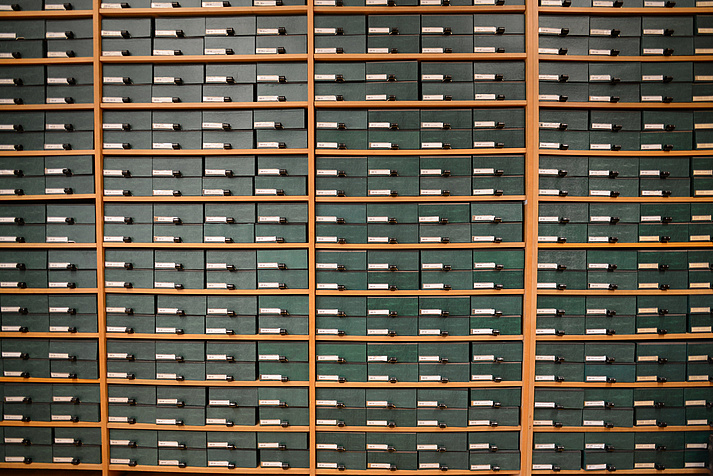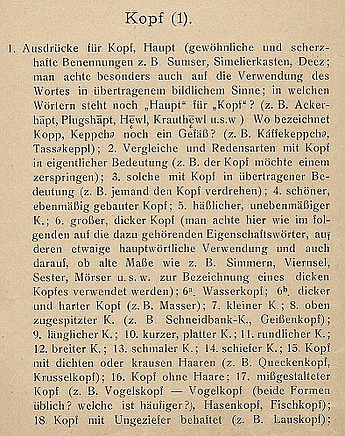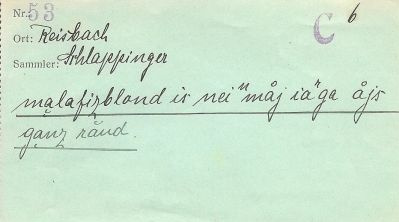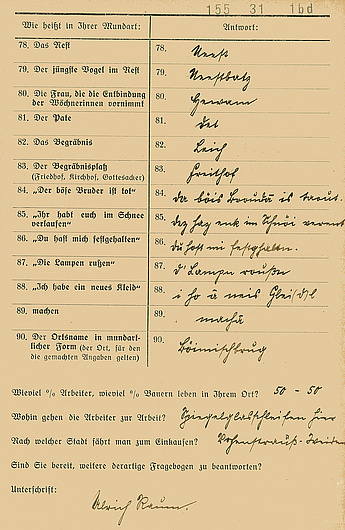
1913–1933: Systematic Questionnaire
In 1913 the „Systematic Questionnaires“ began to be circulated. All in all, until 1930 there had been 109 series sent out. Each questionnaire had a guiding theme. The questions addressed a certain primary word and its range of meanings, as well as compounds, comparisons, proverbs and customs related to the word in question. The usage examples were noted by the test persons on the slips of paper supplied. For the most part, the „collectors“ who answered these questions were elementary teachers who in turn questioned long-established residents. In the years from 1913 until 1915, 41 different questionnaires were sent to each of 350 collectors throughout Bavaria. Because of the war, surveys had to be curtailed in 1915. When the mailing of questionnaires was resumed after the First World War, the network of collectors never became that close-knit again. At the end there were only 38 collectors, two thirds of them from the Bavarian dialect area. The „Systematic Questionnaires“ survey resulted in 780,000 slips with examples of usage, and a further around 6,000 were lost at the end of the Second World War.
1927–1933: Field Exploration Catalogue (direct questioning)
Starting in 1927 redactors went on exploratory tours throughout Bavaria. The material collected was called the “Field Exploration Catalogue“. It is the only material of the Bayerisches Wörterbuch noted down in face-to-face interviews. The main goal was to record exact pronunciations. Locations are concentrated especially in the Alpine region and the transitional zones to East Swabian and East Franconian. All in all, the Field Exploration Catalogue contains about 108,000 example slips.
1927–1940: Dialect Geography Questionnaire
During the 1920’s, the „Dialect Geography Questionnaire“ was created: Short and precise questions (on average 20-30 per questionnaire) were sent to a maximum number of informants. The goal was to install a pilot network for the rapid creation of dialect geography maps. The reason for this: The commission at that time flirted with the idea of developing a Linguistic Atlas of Bavaria.
All in all, 294 series of the questionnaire were sent out, as supplements of the „Wochenschrift zur Pflege von Heimat und Volkstum“. The magazine went as official post to all school administrators. The answers were written directly on the questionnaires. From the Bavarian dialect area, 250 questionnaires of each series were returned. All in all 80,000 questionnaires were returned. They have since been scanned for digital archiving. The result: around 1.3 million examples.
1934: Maurer Questionnaire
In 1934 Friedrich Maurer, professor of German Philology in Erlangen, created a questionnaire with 90 questions for the planned „Ostfränkisches Wörterbuch“, addressing pronunciation and vocabulary. The so-called “Maurer-Questionnaire” was sent to all schools in Bavaria as a supplement of the „Bayerische Schulanzeiger“. Even Wenker’s Deutscher Sprachatlas did not achieve a network of such density. The questionnaires from Bairisch-Bavarian locations were archived in the Bayerische Wörterbuch. They too have now been scanned. About 2,760 questionnaires returned from Bairisch-Bavarian informants resulted in about 250,000 examples.
Sixth and last page of the "Maurer Questionnaire" from Böhmischbruck, district of Vohenstrauß
1958 until today: Word Lists
Since 1958, questionnaires called “word lists” have been sent out. The word lists fill the gaps which emerged after reviewing the existing material by preparing so-called headword lists.
The questions are semasiological, i.e. the quest for the meaning of a word starts with the word, not with the meaning. So far 260 lists with 60 questions each have been sent out and more than 4 million examples. The word lists so far address keywords with initial letters A - R, T - Z. The letter S and parts of R- and W- are still missing.
The number of volunteers completing these lists has varied from 400 to 500.
We gladly welcome any new volunteers and invite them to fill out older lists as well. As from 2017, the lists can be filled in online.
If you are interested, please click on this Link to get in touch with us (Contact). The questionnaires have been scanned and can be viewed here (see Digital Platform).




![[Translate to English:] Hier die Antwort aus Haimhausen DAH auf die Frage nach Bezeichnungen für ‘blond’.](/fileadmin/_processed_/2/4/csm_05-1_Syst_Frgb_malefiz-blond_Haimhsn_d8559d53e1.jpg)

![[Translate to English:] Mundartgeograpischer Fragebogen Nummer 228 aus Teising, Landkreis Mühldorf, mit Zeichnungen](/fileadmin/_processed_/c/3/csm_05-1_Mdag_Frgb_Teising_MUE_0b91fa41b0.jpg)

![[Translate to English:] Wörterliste 35 aus Reichersbeuern, Landkreis Bad Tölz](/fileadmin/_processed_/6/c/csm_05-1_WL_53_Reichersbeuern_TOEL_81f3284726.jpg)